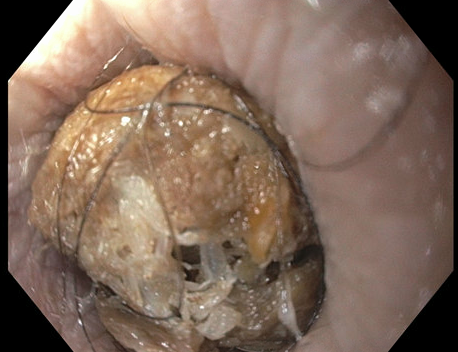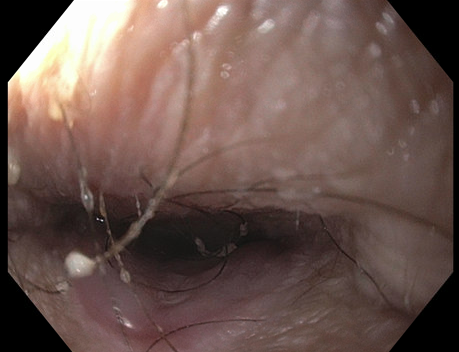Monday Poster Session
Category: Esophagus
P2859 - From Dermis to Digestive Tract: When Skin Flaps Do More Than Expected
Monday, October 27, 2025
10:30 AM - 4:00 PM PDT
Location: Exhibit Hall

Supritha Chintamaneni, MBBS
HCA Healthcare
Kingwood, TX
Presenting Author(s)
Supritha Chintamaneni, MBBS1, Aakriti Soni, MD2, Bilal Ashraf, MD3, Amandeep Kaur, DO1
1HCA Healthcare, Kingwood, TX; 2HCA Healthcare Kingwood Hospital/University of Houston, Houston, TX; 3HCA Healthcare Kingwood Hospital/University of Houston, Kingwood, TX
Introduction: Esophageal reconstruction following laryngeal cancer surgery often involves autologous tissue grafts, such as skin flaps from the thigh. While these flaps provide structural integrity, they may retain characteristics of their original tissue, potentially leading to unexpected complications. This report aims to document an unusual complication of esophageal reconstruction with a thigh skin flap, specifically growth of hair within the esophagus, which can contribute to recurrent food impactions.
Case Description/
Methods: An 84-year-old male with a history of laryngeal cancer (ypT0N0M0 - treated with neoadjuvant radiation, followed by surgical resection and reconstruction with autologous free flap and tracheostomy) presented to the emergency department with food impaction in his throat. He had a known history of prior food impactions, often resolving with consumption of carbonated drinks or administration of glucagon. However, in this instance, these measures were unsuccessful, necessitating further intervention. Patient has undergone esophageal dilations in the past due to strictures.
The patient underwent a computed tomography scan, which revealed a 3.9 cm food bolus in the mid-cervical esophagus. He was unable to swallow his saliva necessitating an emergent EGD. This revealed hair growth in the esophageal mucosa from 7 cm to 20 cm distal to the incisors, leading to food bolus retention. The food bolus was successfully removed using rat-tooth forceps. No esophageal stricture was observed, and the scope was easily passed into the stomach which showed moderate gastritis and multiple non-bleeding duodenal ulcers.
Discussion: Reconstruction of the esophagus using autologous skin flaps is a common technique following extensive surgical resection for malignancy. However, the persistence of adnexal structures such as hair follicles and sebaceous glands in these grafts can result in complications such as hair growth within the esophageal lumen.
While hair growth in esophageal reconstructions using skin flaps is rare, it is a recognized occurrence. The presence of hair can lead to friction, irritation, and food adherence, increasing the risk of obstruction. Management options may include endoscopic removal of hair or debridement, repeated esophageal dilations, laser or electrocoagulation therapy and surgical revision. Awareness of this phenomenon is crucial for clinicians managing patients with post-reconstruction dysphagia.

Figure: Food impaction in the upper third of the esophagus.

Figure: Hair growth in the mucosal tissue extending from 7 cm to 20 cm from the incisors.
Disclosures:
Supritha Chintamaneni indicated no relevant financial relationships.
Aakriti Soni indicated no relevant financial relationships.
Bilal Ashraf indicated no relevant financial relationships.
Amandeep Kaur indicated no relevant financial relationships.
Supritha Chintamaneni, MBBS1, Aakriti Soni, MD2, Bilal Ashraf, MD3, Amandeep Kaur, DO1. P2859 - From Dermis to Digestive Tract: When Skin Flaps Do More Than Expected, ACG 2025 Annual Scientific Meeting Abstracts. Phoenix, AZ: American College of Gastroenterology.
1HCA Healthcare, Kingwood, TX; 2HCA Healthcare Kingwood Hospital/University of Houston, Houston, TX; 3HCA Healthcare Kingwood Hospital/University of Houston, Kingwood, TX
Introduction: Esophageal reconstruction following laryngeal cancer surgery often involves autologous tissue grafts, such as skin flaps from the thigh. While these flaps provide structural integrity, they may retain characteristics of their original tissue, potentially leading to unexpected complications. This report aims to document an unusual complication of esophageal reconstruction with a thigh skin flap, specifically growth of hair within the esophagus, which can contribute to recurrent food impactions.
Case Description/
Methods: An 84-year-old male with a history of laryngeal cancer (ypT0N0M0 - treated with neoadjuvant radiation, followed by surgical resection and reconstruction with autologous free flap and tracheostomy) presented to the emergency department with food impaction in his throat. He had a known history of prior food impactions, often resolving with consumption of carbonated drinks or administration of glucagon. However, in this instance, these measures were unsuccessful, necessitating further intervention. Patient has undergone esophageal dilations in the past due to strictures.
The patient underwent a computed tomography scan, which revealed a 3.9 cm food bolus in the mid-cervical esophagus. He was unable to swallow his saliva necessitating an emergent EGD. This revealed hair growth in the esophageal mucosa from 7 cm to 20 cm distal to the incisors, leading to food bolus retention. The food bolus was successfully removed using rat-tooth forceps. No esophageal stricture was observed, and the scope was easily passed into the stomach which showed moderate gastritis and multiple non-bleeding duodenal ulcers.
Discussion: Reconstruction of the esophagus using autologous skin flaps is a common technique following extensive surgical resection for malignancy. However, the persistence of adnexal structures such as hair follicles and sebaceous glands in these grafts can result in complications such as hair growth within the esophageal lumen.
While hair growth in esophageal reconstructions using skin flaps is rare, it is a recognized occurrence. The presence of hair can lead to friction, irritation, and food adherence, increasing the risk of obstruction. Management options may include endoscopic removal of hair or debridement, repeated esophageal dilations, laser or electrocoagulation therapy and surgical revision. Awareness of this phenomenon is crucial for clinicians managing patients with post-reconstruction dysphagia.

Figure: Food impaction in the upper third of the esophagus.

Figure: Hair growth in the mucosal tissue extending from 7 cm to 20 cm from the incisors.
Disclosures:
Supritha Chintamaneni indicated no relevant financial relationships.
Aakriti Soni indicated no relevant financial relationships.
Bilal Ashraf indicated no relevant financial relationships.
Amandeep Kaur indicated no relevant financial relationships.
Supritha Chintamaneni, MBBS1, Aakriti Soni, MD2, Bilal Ashraf, MD3, Amandeep Kaur, DO1. P2859 - From Dermis to Digestive Tract: When Skin Flaps Do More Than Expected, ACG 2025 Annual Scientific Meeting Abstracts. Phoenix, AZ: American College of Gastroenterology.

